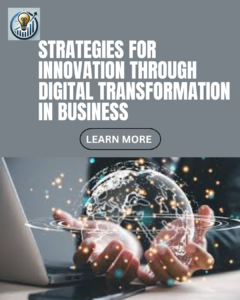Strategies for Innovation Through Digital Transformation in Business

Businesses that want to grow, become more efficient, and be sustainable must now embrace digital change. Businesses can improve operations and maintain their competitiveness in the quickly changing market of today by combining cutting-edge technologies and creative approaches. Using cutting-edge technologies, data insights, and sustainable practices, this essay examines practical ways to spur creativity through digital transformation.
Overview
The term "digital transformation" describes how businesses are integrating digital technologies into every facet of their operations, thereby altering the way they provide value to their clients. Businesses are using digital tools to boost revenue, optimize operations, and advance sustainability as a result of the growing use of AI in business innovation and the acceptance of innovative technology. In addition to spurring innovation, these shifts are changing the corporate environment going forward.
Key Strategies for Innovation Through Digital Transformation
Embracing Emerging Technologies
Artificial intelligence (AI), machine learning, blockchain, and the Internet of Things (IoT) are examples of emerging commercial technologies that are transforming entire industries. These tools help businesses make better decisions, automate procedures, and improve customer experiences. For instance:
-
AI in Business Innovation: AI enables companies to forecast trends, analyze enormous volumes of data, and customize interactions with clients. For example, chatbots driven by AI lower operating expenses while improving customer service.
-
IoT for operational efficiency: By gathering data in real time, IoT devices help companies improve supply chain management, cut waste, and streamline operations.
Businesses can gain a competitive edge, improve workflows, and open up new prospects by implementing these technologies.
Investing in Data-Driven Decision Making
The foundation of business's digital transformation is data. Businesses that put an emphasis on data-driven decision-making are better able to see trends, seize opportunities, and formulate well-informed strategic plans. Here's how:
-
Advanced Analytics: Actionable insights into consumer behavior and market dynamics are offered by tools like big data platforms and predictive analytics.
-
Personalized Marketing: Companies can create focused marketing strategies that increase engagement and loyalty by examining consumer data.
-
Better Resource Allocation: By optimizing resource use, data-driven insights lower costs and boost productivity.
Businesses may make more informed decisions that drive innovation and expansion by investing in analytics tools and cultivating a data-centric culture.
Fostering a Digital-First Culture
More than simply technology is needed for a successful digital transformation; a mentality change is also necessary. Employees are more likely to accept innovation and adjust to new technology when a digital-first culture is promoted. Important tactics consist of:
-
Training and Development: To assist staff in comprehending and efficiently using digital tools, offer continuous training courses.
-
Encouraging Collaboration: To facilitate communication and encourage departmental collaboration, use digital platforms.
-
Empowering Leadership: Leaders need to encourage their teams to welcome change and support digital projects.
Businesses can make sure that their digital transformation initiatives are successful in the long run by fostering an innovative and flexible culture.
Leveraging Cloud and Hybrid Solutions
Scalable, secure, and adaptable digital transformation in a company requires cloud and hybrid solutions. These solutions have a number of advantages:
-
Scalability: By enabling companies to adjust resources in response to demand, cloud platforms lower expenses and boost productivity.
-
Improved Collaboration: Teams can collaborate easily from any location with cloud-based technologies, which promotes creativity and productivity.
-
Data security: Hybrid solutions guarantee the protection of sensitive data by striking a balance between on-premises and cloud-based security measures.
Businesses may develop more quickly and adjust to shifting market conditions by investing in cloud and hybrid technologies.
Case Studies of Successful Digital Transformation
First Case Study: Retail Sector AI-driven analytics were used by a top retail corporation to improve inventory control. They decreased overstock and out-of-stock problems by examining consumer preferences and buying trends, which led to a 20% rise in revenue.
Second Case Study: Manufacturing Industry Production lines were equipped with IoT-enabled sensors by a manufacturing company. This system reduced downtime and increased efficiency by 30% by giving real-time insights into equipment performance.
These examples show how firms can achieve measurable outcomes by utilizing AI in business innovation and new technologies.
Overcoming Digital Transformation Obstacles
There are obstacles to digital transformation in companies, such as reluctance to change, financial limitations, and problems integrating technology.Here's how to handle these problems:
Change management: Create a transparent communication strategy to allay staff worries and emphasize the advantages of the digital transition.
Budget Optimization: To efficiently control expenses, begin small with test projects and grow successful efforts.
Technology Integration: To guarantee the smooth integration of new technologies into current systems, collaborate with knowledgeable partners.
Businesses may create the conditions for a more seamless transformation journey by proactively tackling these obstacles.
Conclusion
One of the most potent forces behind innovation and expansion in business is digital transformation. Businesses may maintain their competitiveness in a constantly shifting market by adopting innovative technologies, making investments in data-driven decision-making, cultivating a digital-first culture, and utilizing cloud and hybrid solutions. Prioritizing sustainable digital transformation also guarantees that companies help create a more environmentally friendly future.
At SmartBusinessIQ, we think that the future of a company is largely determined by innovation through digital transformation. By putting these tactics into practice, your company may succeed and set the standard for creating a more inventive, efficient, and sustainable world.






